Page 108 of 370
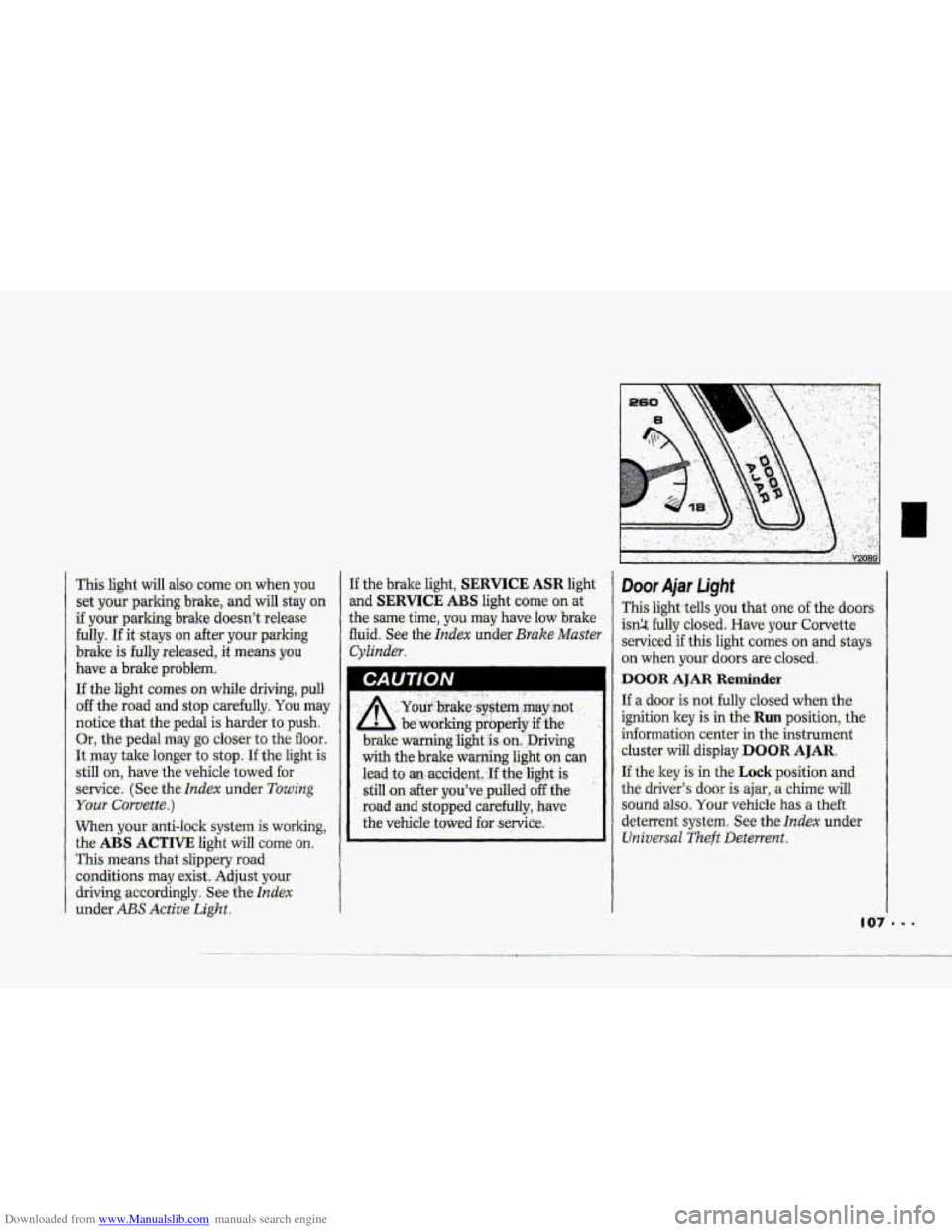
Downloaded from www.Manualslib.com manuals search engine :. , .. .. . .. .. .I . ..., . ,, :. .. . - ’, . . . ,, y&jd . ~ ., ,. - :, .
Door Ajar Light
This .li.ght.tells you that one of the doors
isn2 fully closed. Have your Corvette
serviced if this light
comes on and stays
on when your doors are closed.
DOOR AJAR Reminder
If a-do-or is not fully-closed when the
ignition ley is in the Run position, the
hformafion center in the instrument
cluster will diq$ay DOOR AJAR.
If the ley is in the Lock position and
the driver’s door is ajaq :a chime will
sound also. Your vehicle has a theft
deterrent system.
See the Index under
Universal Theft D-gterrent.
This; light will also cor ne^ on when y0.u
set your parking brake:, and Will stay on
if your parking brake doesn’t releast.
fully. If.itstay-s on after your parking
brake is fully released, it means you
have a brake. problem.
If the light comes on while driving, pull
off the road and stop carefully. You may
notice that
the p.eda1 is harder ta push.
Or, the-pedal may go closerto the floor.
It may tale longer to stop. If the light is
still on, have the vehi-cle towed fo’r
service. (See the Index under Towing
Your Corvette. )
When yo.ur ,aziti-loclr systerfi is working,
the
ABS ACTIVE light will come on.
This means that slippe-ry road
conditions may exist. Adjust your
driving accordingly.
See the Index
under ABS Active Light.
if the brake light, SERVICE ASR light
and SERVICE ABS Iight come on at
the same time, you may have low brake
fluid. See the Index under Brake Master
Cylinder.
GAU I IUN I
-with the brake- warning light. on can
lead .to awaccident. ,If thclight is
stiI.1 .on after you’ve.:,ptilled off the
mad- .ad.
st0ppe.d carefully; :have
the vehicle.towed
for service.
Page 196 of 370
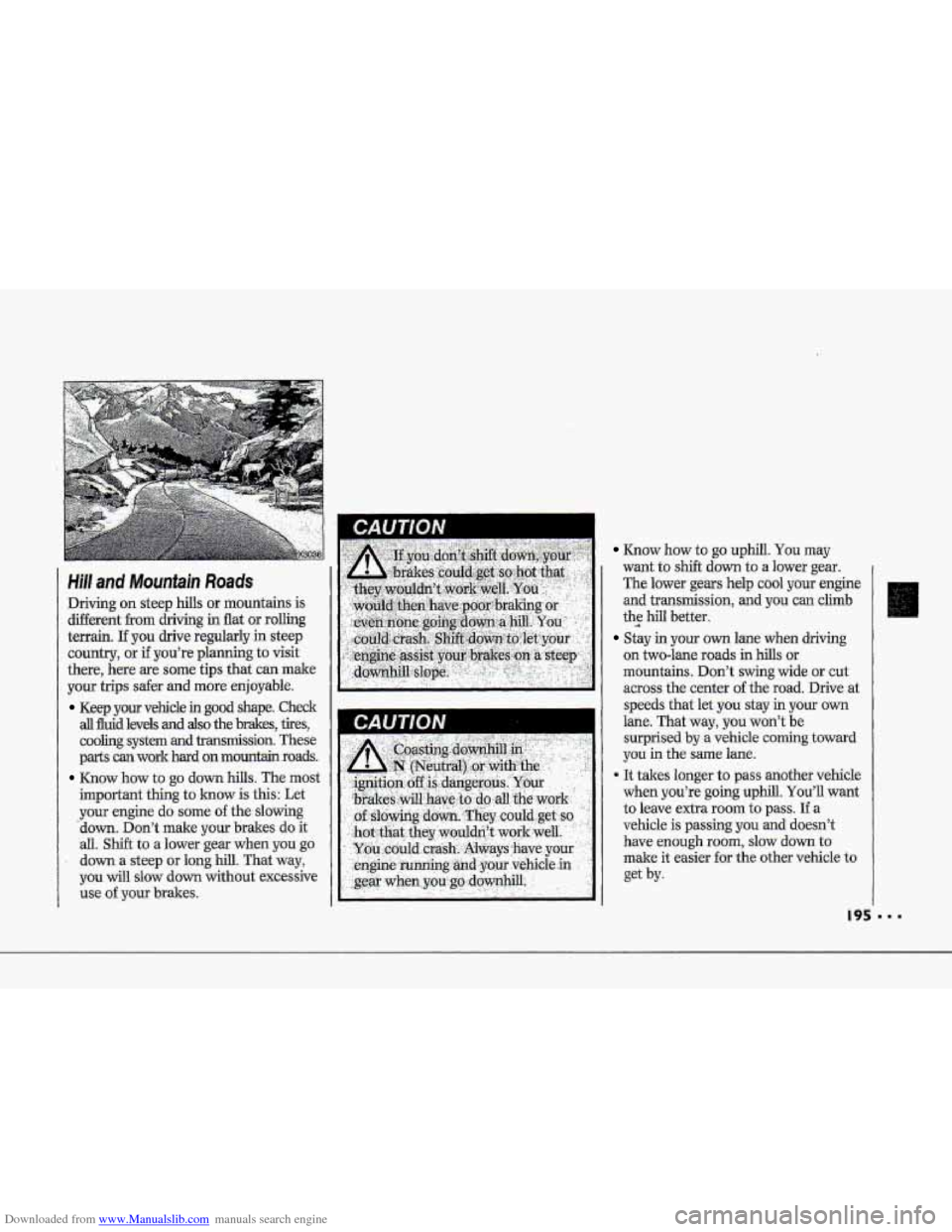
Downloaded from www.Manualslib.com manuals search engine f
F"
Hin and Mounfain Roads
Driving on steep hills or mountains is
dif€erent fram driving in flat or rolling
terrain. If you drive regularly in steep
country,
or if you're planning to visit
there, here are -some tips that can make
your trips safer and.more enjoyable.
Keep your vehicle in good shape. Check
all fluid levels and also the brakes, tires,
cooling system and transmission. These
parts can work hard on mountain roads.
Know how to go down hills. The most
important thing to how is this: Let
your engine do. some of the slowing
'down. Don't make your brakes do it
all. Shift to a lower gear when you go
down .a steep or long hill. That way,
you will slow down without excessive
use of your brake-s.
Know how to go uphill. You may
want to shift dawn to a lower gear.
The lower gems help cool your engine
and transmission, and you can clin-ib
the *f hiU better.
Stay in your own lane when driving
on two-lane roads in hills or
mountains. Don't swing wide .or cut-
across. the .center of the road. Drive at
speeds that-let-you stay 'in your own
lae. That way, you won't be
surprised by,a vehicle- coming toward
you
in the same lane.
* It takes longer to pass another vehicle-
when you're going uphill. You'll want
to leave extra room to pass. If a
vehicle is passing you and doesn't
have enough room, slow down to
make it easier for the other vehicle to
get by.
Page 199 of 370
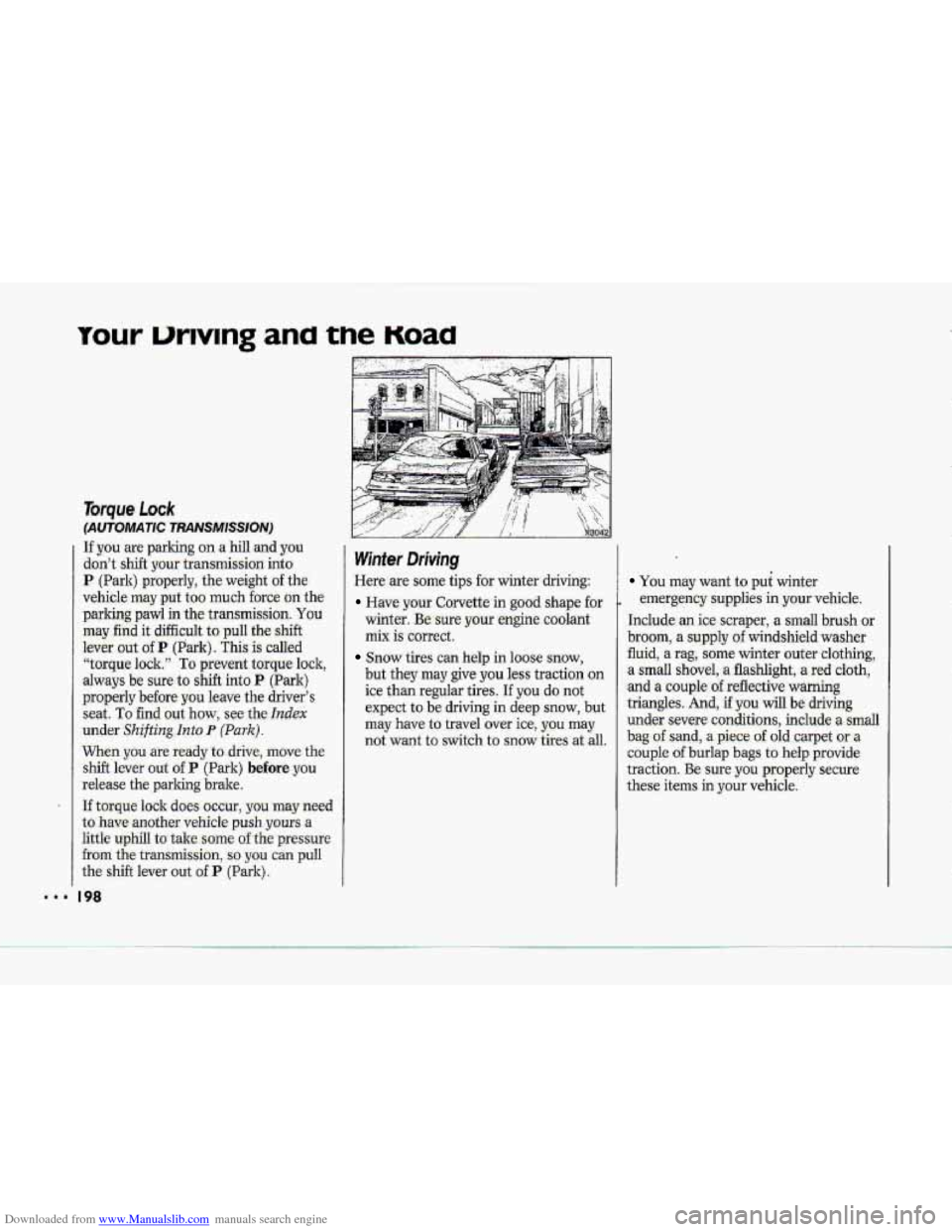
Downloaded from www.Manualslib.com manuals search engine your urlvlng ana tne Koaa
Torque Lock
(AUTQMATIC TRANSMISSION)
If you are parking on a hill and you
don’t shift your transmissian into
P (Park) properly, the weight of the
vehicle may put
too much force on the
parking pawl in the transmission. You
may find it difficult to pull the shift
lever out of
P (Ihrlr). This is called
“torque
lock.” To prevent torqu’e lock,
always
be sure to shift into P (Park)
properly before you leave the driver’s
seat.
To find out how, see the Index
under Shifting Into P (Park).
When you are ready to drive, move the
shift lever out
of P (Park) before you
release the parking brake.
If torque lock does occur, you may need
to. have another vehicle push yours a
little uphill to take some of-the pressure
from the transmiss.ion, ‘so you can pull
the
shifi lever out of P (Park).
I98
Winter Driving
Here are some tips for winter driving:
Have your Corvette in good shape for
winter.
Be sure your engine coolant
mix is correct.
Snow tires can help in loose snow,
but they may give you less traction on
ice than regular tires. If you do not
expect to be driving
in deep snow, but
may have
to travel over ice, you may
not want to switch to
snow tires at .all.
YOU may want to put winter
emergency supplies in your vehicle.
Include
an ice scraper, a small brush or
broom, a supply of windshield washer
fluid, a rag, some winter outer clothing,
a small shovel, a flashlight, .a red cloth,
and a couple of reflective warning
triangles. And, if-you will be driving
under severe conditions,
include a small
bag of sand, a piece of old carpet or a
couple of burlap bags to help provide
traction. Be sure you properly secure
these items in your vehicle.
Page 247 of 370
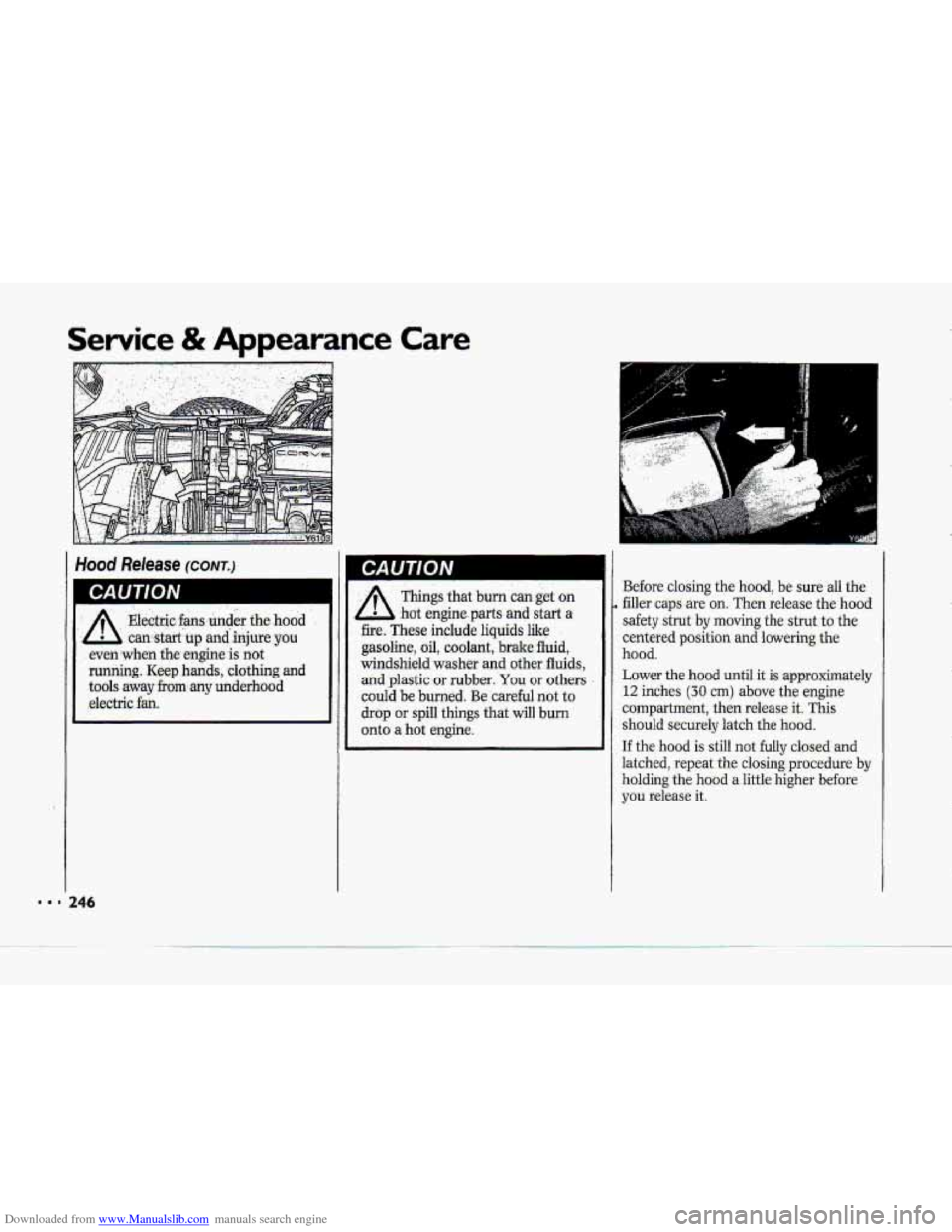
Downloaded from www.Manualslib.com manuals search engine I
Service & Appearance Care
:A Electric. fansunder the hood
can stariup and .injure yuu
even when the engine is not
running. Keep hands, clothing and
tools away frornany underhood
electric
fan.
46
CAUTION
A
Things that burn can get on
hot engine parts and start a
fire. These include liquids like
gasoline,
oil, coolant, brake fluid,
windshield washer and other fluids,
and plastic or rubber. You or others
could be burned. Be careful not to
&op or spill things that will bum
onto a hot engine. Before
closing the
hood, be sure all the
filler caps are on. Then release the
hood
safety strut by moving the strut to the
centered position and lowering the
hood.
Lower the hood'until it is approximately
12 inches (30 cm) above the engine
compartment, then release it. This
should securely latch the hood.
If the hood is still not fully closed and
latched, repeat the
closing procedure by
holding the
hood a little higher before
you release it.
Page 248 of 370
Downloaded from www.Manualslib.com manuals search engine 0 Y6105
LT7 hgine (CODE PI
t a Automatic Transmission Fluid
2. Hydraulic Clutch Fluid Reservoir
3. Battery
4. Brake Fluid Reservoir
5. Air Cleaner
Dipstick
(if equipped)
(if equipped)
6. Coolant Recovery
Tank
7. Power Steering Fluid Reservoir
8. Engine Oil Fill Cap
9. Engine Oil Dipstick
IO. Coolant High Fill Reservoir
11. Windshield Washer Fluid Reser aoir
Page 249 of 370
Downloaded from www.Manualslib.com manuals search engine Service & Appearance Care ..
\!
1 LT5 Engine (CODEJ)
1. Hydraulic Clutch Fluid Reservoir
2. Battery
3. Brake Fluid Reservoir
4. Power Steering Fluid Reservoir
5. Air Cleaner
6. Coolant Recovery Tank
7. Engine Oil Fill Cap
8. Engine Oil Dipstick
9. Coolant High Fill Reservoir
IO. Windshield Washer Fluid Reservoir
.I. 248
Page 259 of 370
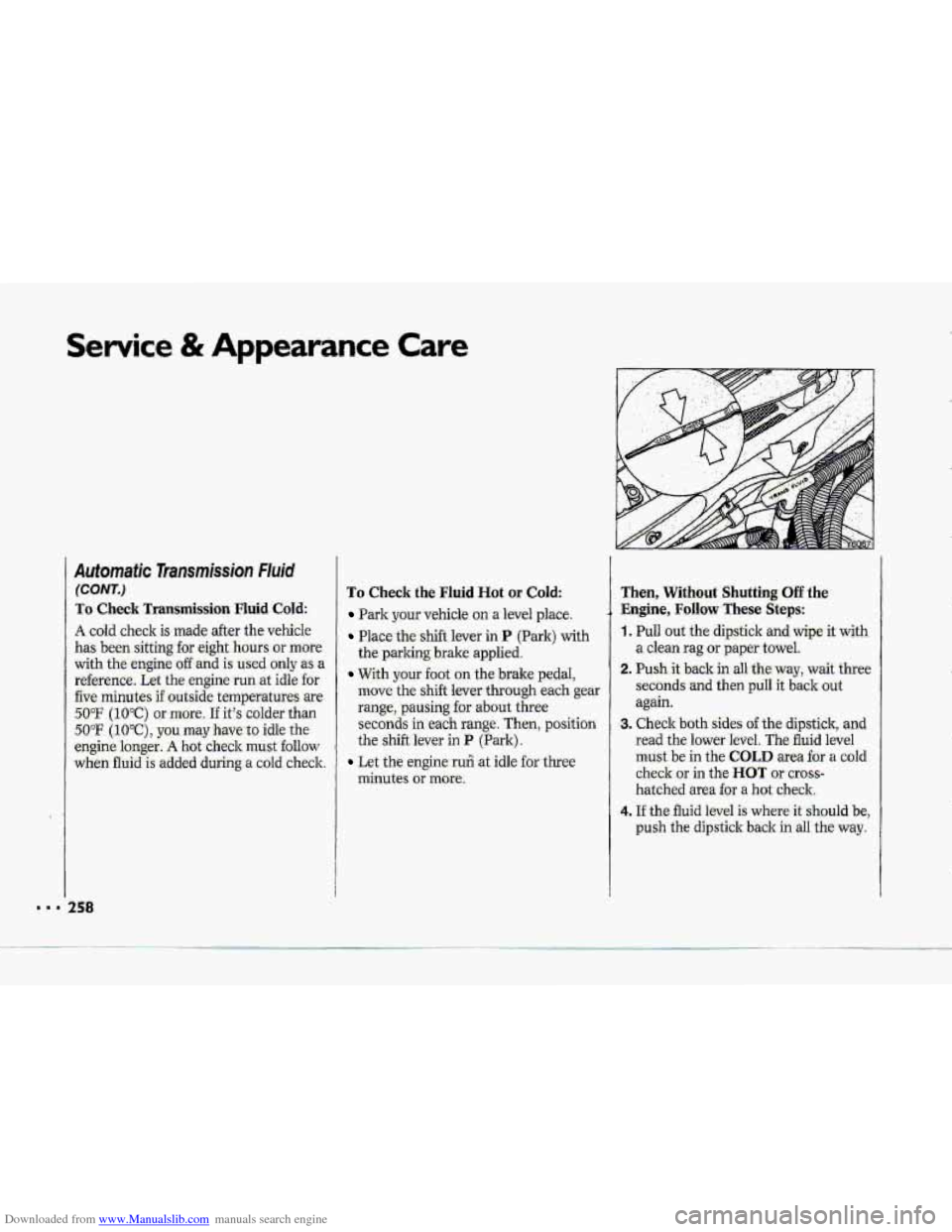
Downloaded from www.Manualslib.com manuals search engine Service & Appearance Care
Automatic Transmission Fluid
(C.ONT.)
To Check Trafisinission Fluid Cold:.
A cold check is made after the-vehicle
has been sitting for eight hours-or miore
with. the engine offand is used only as :a
feference. Let the,engine run at idle for
five minutes if &utside temper&n%:_s are
50QF (10%) or-mare. If it's colder than
5QoF [lUaC), you may have-to idle the
engine longgr; A hat check must follou7
wheaffuid. is added dw"lqg a cold.check.
To Check the Fluid Hot or Cold
Park your vehicle- on: a- level place.
Place the ;shift lever in P (Park) with
With your foot on the brake pedal,
the .parkingbrake applied.
mave the shift lever through each gear
range, pausing for about three
seconds in each range. Then, p-asition
the-s-hift'lever in P (Park).
minutes ,or more;
Let the engine rd .at idle for three
Then, Without Shutting Off the
Engine, Follow- These Steps:
1. Pull out the dipstick and wipe it with
a
clean rag or paper towel.
2. Push it back in all the. way, wait three
seconds and then pull; h back out
again.
3. Check b.& stdes af the dipstick, and
read the
loweg. limd. The hid he1
must be in the COLD area for a cold
checkor in th-e HOT or er0s.s-
hatched area for a hat checl<.
4. If the fluid level is whe$e it should. be,
push the dipstick b:ack in all the way.
Page 271 of 370
Downloaded from www.Manualslib.com manuals search engine Service & Appearance Care
Brake Master Cylinder
Your brake master cylinder is filled with
DOT-3 brake fluid.
There are only two reasons why the
brake fluid level
in your master cylinder
might go down. The first is that the
brake fluid goes down to an acceptable
level during normal brake lining wear.
When new
linings are put in, the fluid
level goes back up.
The other reason is that fluid is Iealring
out
of the brake system. If it is, you
should have your brake system fixed,
since
a leak means that sooner or later
your brakes won’t work well, or won’t
work at all.
So, it isn’t a good idea to “top off” your
brake fluid. Adding brake fluid won’t
correct
a leak. If you add fluid when
your linings are worn, then you’ll have
too much fluid when you get new brake
linings. You should add (or remove)
brake fluid,
as necessary, only when
work
is done on the brake hydraulic
system.